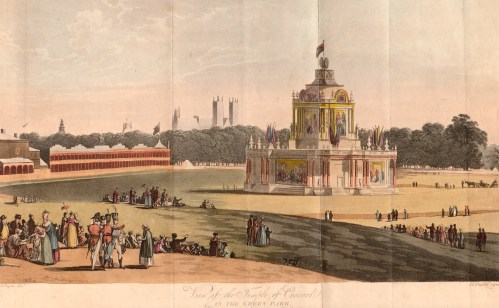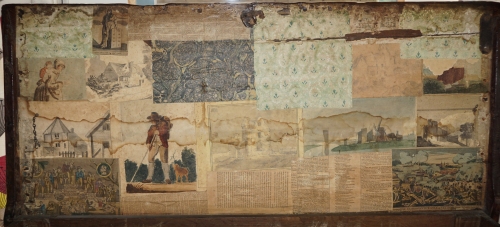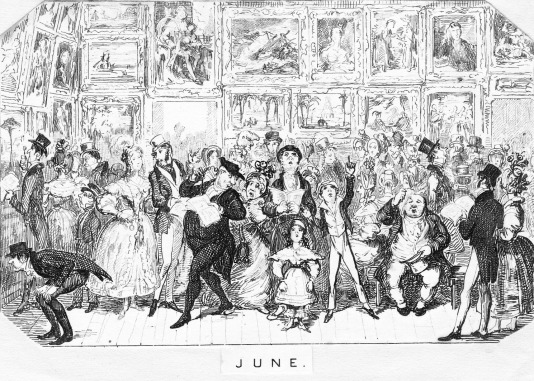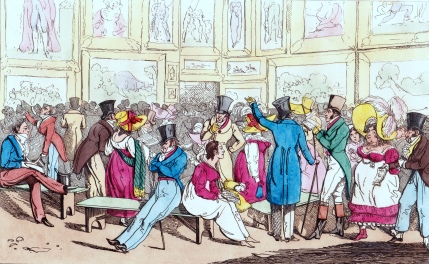So much has been written – and is being written – about the battle of Waterloo itself that this post is not going to go into any details but will concentrate on what was known to be happening in London. (The detail below shows the fighting on the left wing of the battle.)

On the 18th Londoners were going about their normal Sunday business – attending church, followed, for the gentlemen, by reading the papers which had no up-to-date news from Flanders.
Readers could safely turn to lighter matters such as the report in t Marriages column: “Some days ago, at Gretna Green, Capt. Bontein, of the Life Guards, son of Sir G.B. to the daughter of Sir E. Stanley. The parties rode out from Lady Bontein’s to take an airing before dinner; they took post-chaise and four at Barnet, and proceeded to Gretna Green, wither they were unsuccessfully pursued by Lady Stanley. The only objection to the match, was, it is said, the age of the bride, who is under fourteen and has a handsome fortune. The parties have since been re-married in London.” Where, presumably, Captain Bontein was enjoying the company of his child bride and her handsome fortune while his comrades plunged into battle.


A glimpse into the state of the London streets, with vast herds of livestock being driven through them daily, is captured in the report that, “On Friday-forenoon, a large bullock that ran from a drove in Newgate-street, ran into the shop of Messrs. Baldwin & Co. booksellers, and the parlour door being open, he walked in, where there were three or four ladies sitting who were very much frightened…they were at length rescued… by a drover…all the furniture had to be piled in one corner to make room for the animal to turn around: he then walked out very deliberately.” The picture shows a detail from a print of Soho Square (Ackermann’s Repository 1812)
By Monday 19th there was still nothing in the newspapers, but rumours of three days’ fighting around Brussels were beginning to spread by word of mouth from the Channel couriers.
Meanwhile, on the battlefield, the first tourists had arrived from Brussels, despite the desperate needs of the wounded in the city and on the battlefield, the state of the roads and the appalling scenes. In his Journal of the Waterloo Campaign, Kept through the Campaign of 1815, Cavalié Mercer, who commanded G Troop Royal Horse Artillery during the battle, records some of the very first tourists. On the morning of the 19th he recalls surveying the field, helping get water to the wounded and seeing his men were fed, surrounded by mangled corpses and the wounded. “We had not yet finished our meal, when a carriage drove on the ground from Brussels, the inmates of which, alighting, proceeded to examine the field. As they passed near us, it was amusing to see the horror with which they eyed our frightful figures; they all, however, pulled off their hats and made us low bows. One, a smartly-dressed middle-aged man, in a high cocked-hat, came to our circle, and entered into conversation with me on the events of yesterday. He approached holding a delicately white perfumed handkerchief to his nose; stepping carefully to avoid the bodies (at which he cast fearful glances en passant), to avoid polluting the glossy silken hose that clothed his nether limbs…With a world of bows my man took leave, and proceeded, picking his steps with the same care as he followed the route of his companions in the direction of Hougoumont.”

Finally some hard news reached the London papers on Tuesday 20th June, albeit four days out of date. Under the headline, “Commencement of Hostilities” the Morning Post reported, “Yesterday afternoon an Officer arrived with dispatches from the Duke of WELLINGTON, announcing the important fact of BONAPARTE having, soon after his arrival on the frontiers, put his army in motion, and attacked the Prussian outpost at Givet. This took place on the morning of the 16th, on the evening of which day a Prussian officer arrived in Brussels to communicate the intelligence to the Duke of WELLINGTON. His Grace lost not a moment in putting his whole army in motion…A general battle has in all probability ere taken place. In Heaven we trust that our confident hopes in regard to it will be speedily and completely realised.”
The Morning Post on the 21st reported rumours of a great battle and stated that, “an Officer was on the road to London with the official accounts, and in the meantime the report brought by MR SUTTON, the Packet Agent [ie in charge of the mail boats] was sufficiently circumstantial to prove its authenticity.” The article repeated the news about the 16th and stated that Wellington had brought Bonaparte into “a sanguinary contest” on the 17th. News of the death of General Picton was given, but all the details were unclear.
By now Napoleon had reached Paris and late that same evening Wellington’s exhausted aide Henry Percy arrived in London, having started out a few hours after the battle with the Duke’s dispatches and two captured eagles. He travelled day and night, with the eagles poking out of the chaise window, and reached Horse Guards between eleven and midnight. He found no-one in authority but eventually tracked Lord Liverpool down who insisted they go immediately to tell the Prince Regent who was dining with the Duke of York at Mrs. Boehm’s house (now no.14) in St. James’s Square.
Lord Liverpool, followed by footmen carrying the eagles, announced to the Prince Regent, “I have brought Major Percy, who comes with the news of a great victory for your Royal Highness.”
“Not Major Percy, but Lieut.-Colonel Percy,” said the Prince as Percy knelt and kissed his hand. ” We have not suffered much loss, I hope.”
“The loss has been very great indeed,” replied Percy and the Regent burst into tears. Major Percy was finally to escape and go to bed for the first time since the battle.
The second edition of the Morning Post on the morning of the 22nd carried “Official Bulletin of the Complete Overthrow of Bonaparte’s Army With a List of the British Officers Killed or Wounded.” The dispatch was brief and to the point, the list of casualties very long – and that was just the officers. Londoners would have been left in no doubt that a great victory had been won at enormous cost. The Morning Post wrote, “With hearts gratefully elate (sic) and all thanks due to Heaven for the event, we have this day the supreme happiness of announcing one of the most complete and comprehensive victories ever attained, even by British valour…While Bonaparte… coward at heart…narrowly effected his escape.”
As Londoners were reading the news, in Paris Napoleon was abdicating in favour of his son.
The first tourists were soon to be followed by a positive flood – the grieving, the curious, the poetic, the patriotic – and the souvenir hunting. You can meet a selection here.


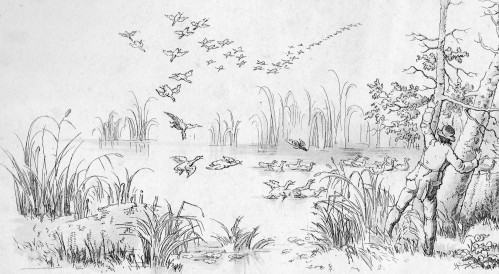



 Certainly, the London Encyclopedia records no interesting inhabitants until the middle of the 19th century, although the staircase of number 20 was the location of the cover shoot for the Beatles’ Please Please Me.
Certainly, the London Encyclopedia records no interesting inhabitants until the middle of the 19th century, although the staircase of number 20 was the location of the cover shoot for the Beatles’ Please Please Me.




 The image above is from La Belle Assemblée for October 1809 and shows ‘Sea Coast Promenade Fashion.’
The image above is from La Belle Assemblée for October 1809 and shows ‘Sea Coast Promenade Fashion.’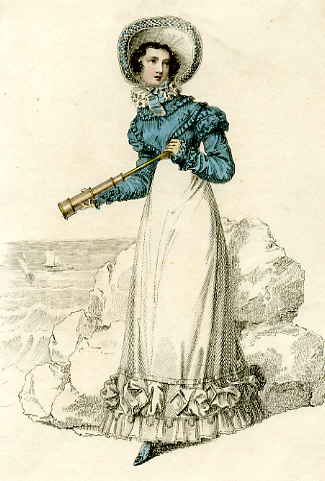 Somewhat later – I do not have a date for this, but it is c1820 – is this ‘Walking Dress’ from Ackermann’s Repository. I can’t help feeling that this lady is looking positively shifty as she readies her telescope.
Somewhat later – I do not have a date for this, but it is c1820 – is this ‘Walking Dress’ from Ackermann’s Repository. I can’t help feeling that this lady is looking positively shifty as she readies her telescope.




 What did one wear to get to and from those bathing machines? The ever-inventive Mrs Bell produced a magnificent ‘Sea Side Bathing Dress’ for the August 1815 edition of La Belle Assemblée. This is not the costume for entering the sea but for wearing to get there, and it is lavishly trimmed in drooping green, presumably to imitate seaweed. Note the bag she is carrying. This contains Mrs Bell’s ‘Bathing Preserver’ which she produced in 1814. You can see it in its bag again below (La Belle Assemblée September 1814). Here the lady is wearing ‘Sea Side Morning Dress’ with ‘Bathing Preserver. Invented & to be had exclusively of Mrs Bell, No.26 Charlotte Street, Bedford Square.’ The Preserver is in the bag lying beside her chair.
What did one wear to get to and from those bathing machines? The ever-inventive Mrs Bell produced a magnificent ‘Sea Side Bathing Dress’ for the August 1815 edition of La Belle Assemblée. This is not the costume for entering the sea but for wearing to get there, and it is lavishly trimmed in drooping green, presumably to imitate seaweed. Note the bag she is carrying. This contains Mrs Bell’s ‘Bathing Preserver’ which she produced in 1814. You can see it in its bag again below (La Belle Assemblée September 1814). Here the lady is wearing ‘Sea Side Morning Dress’ with ‘Bathing Preserver. Invented & to be had exclusively of Mrs Bell, No.26 Charlotte Street, Bedford Square.’ The Preserver is in the bag lying beside her chair.







